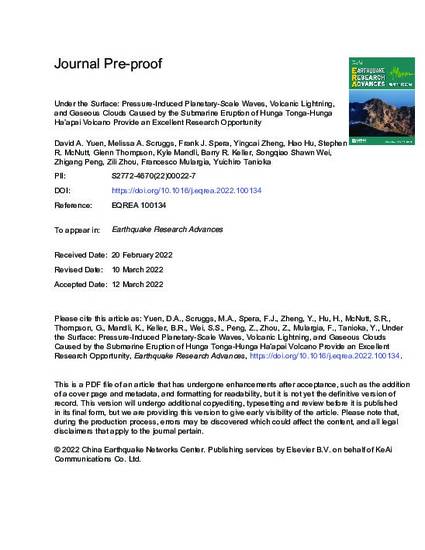
- Hunga Tonga-Hunga Ha’apai,
- atmospheric pressure wave,
- tsunami wave,
- volcanic lightning,
- phreatoplinian eruption
We present a narrative of the eruptive events culminating in the cataclysmic 15 January 2022 eruption of Hunga Tonga-Hunga Ha’apai Volcano by synthesizing diverse preliminary seismic, volcanological, sound wave, and lightning data available within the first few weeks after the eruption occurred. The first hour of eruptive activity produced fast-propagating tsunami waves, long-period seismic waves, loud audible sound waves, infrasonic waves, exceptionally intense volcanic lightning and an unsteady volcanic plume that transiently reached—at 58 km—the Earth’s mesosphere. Energetic seismic signals were recorded worldwide and the globally stacked seismogram showed episodic seismic events within the most intense periods of phreatoplinian activity, and they correlated well with the infrasound pressure waveform recorded in Fiji. Gravity wave signals were strong enough to be observed over the entire planet in just the first few hours, with some circling the Earth multiple times subsequently. These large-amplitude, long-wavelength atmospheric disturbances come from the Earth’s atmosphere being forced by the magmatic mixture of tephra, melt and gasses emitted by the unsteady but quasi-continuous eruption from 0402±1—1800 UTC on 15 January 2022. Atmospheric forcing lasted much longer than rupturing from large earthquakes recorded on modern instruments, producing a type of shock wave that originated from the interaction between compressed air and ambient (wavy) sea surface. This scenario differs from conventional ideas of earthquake slip, landslides, or caldera collapse-generated tsunami waves because of the enormous (∼1000x) volumetric change due to the supercritical nature of volatiles associated with the hot, volatile-rich phreatoplinian plume. The time series of plume altitude can be translated to volumetric discharge and mass flow rate. For an eruption duration of ∼12 hours, the eruptive volume and mass are estimated at 1.9 km3 and ∼2,900 Tg, respectively, corresponding to a VEI of 5-6 for this event. The high frequency and intensity of lightning was enhanced by the production of fine ash due to magma—seawater interaction with concomitant high charge per unit mass and the high pre-eruptive concentration of dissolved volatiles. Analysis of lightning flash frequencies provides a rapid metric for plume activity and eruption magnitude. Many aspects of this eruption await further investigation by multidisciplinary teams. It represents a golden opportunity for fundamental research regarding the complex, non-linear behavior of high energetic volcanic eruptions and attendant phenomena, with critical implications for hazard mitigation, volcano forecasting, and first-response efforts in future disasters.
Earthquake Research Advances, v. 2, issue 3, art. 100134
Available at: http://works.bepress.com/stephen-mcnutt/133/
